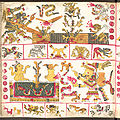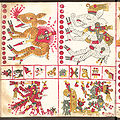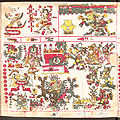- Codex Borgia
-
The Codex Borgia (or Borgia Codex or Codex Yoalli Ehecatl) is a Mesoamerican ritual and divinatory manuscript. It is generally believed to have been written before the Spanish conquest of Mexico, somewhere within what is now today southern or western Puebla. The Codex Borgia is a member of, and gives its name to, the Borgia Group of manuscripts.
The codex is made of animal skins folded into 39 sheets. Each sheet is a square 27 cm by 27 cm (11x11 inches), for a total length of nearly 11 meters (35 feet). All but the end sheets are painted on both sides, providing 76 pages. The codex is read from right to left.
The Codex Borgia is named after the Italian Cardinal Stefano Borgia, who owned it before it was acquired by the Vatican Library. In 2004 Maarten Jansen and Gabina Aurora Pérez Jiménez proposed that it be given the indigenous name Codex Yoalli Ehecatl, Nahuatl for "Night and Wind", although it is not certain that its creators were Nahuas.[1]
 Page 71 of the Codex Borgia, depicting the sun god, Tonatiuh.
Page 71 of the Codex Borgia, depicting the sun god, Tonatiuh.
Contents
History
The Codex Borgia was brought to Europe, likely Italy, some time in the early Spanish Colonial period. It was discovered in 1805 by Alexander von Humboldt among the effects of Cardinal Stefano Borgia. The Codex Borgia is presently housed in the Apostolic Library, the Vatican.
Contents
1–8
The first eight pages list the 260 day signs of the tonalpohualli (day sign), each trecena of 13 signs forming a horizontal row spanning two pages. Certain days are marked with a footprint symbol. Divinatory symbols are placed above and below the day signs.
Sections parallel to this are contained in the first eight pages of the Codex Cospi and the Codex Vaticanus B. However, while the Codex Borgia is read from right to left, these codices are read from left to right. Additionally, the Codex Cospi includes the Lords of the Night alongside the day signs.
9–14
Pages 9 to 13 are divided into four quarters. Each quarter contains one of the twenty day signs, its patron deity, and associated symbols.
Page 14 is divided into nine sections for each of the nine Lords of the Night. They are accompanied by a day sign and symbols indicating positive or negative associations.
15–17
Pages 15 to 17 depict deities associated with childbirth. Each of the twenty sections contains four day signs.
The bottom section of page 17 contains a large depiction of Tezcatlipoca, with day signs associated with different parts of his body.
18–21
22–28
29–46
Pages 29 through 46 of the codex constitute the longest section of the codex, and the most enigmatic. They apparently show a journey but the complex iconography and the lack of any comparable document have led to a variety of interpretations ranging from an account of actual historical events, to the passage of Quetzalcoatl -- as a personification of Venus[citation needed] -- through the underworld, to a "cosmic narrative of creation". The sequence apparently ends with a New Fire ceremony, marking the end of one 52-year cycle, and the start of another.
Images of pages 29–4647–56
Pages 47 through 56 show a variety of deities, sacrifices, and other complex iconography.
Images of pages 47–5657–60
Pages 57 through 60 allowed the priest to determine the prospects for favorable and unfavorable marriages according to the numbers within the couple’s names.
61–70
Pages 61 through 70 are similar to the first section, showing various day signs winding around scenes of deities. Each of the 10 pages shows 26 day signs.
Images of pages 61–7071–76
Page 71 depicts Tonatiuh, the sun god, receiving blood from a decapitated bird. Surrounding the scene are the thirteen Birds of the Day, corresponding to each of the thirteen days of a trecena. Page 72 depicts four deities with day signs connected to parts of their bodies. Each deity is surrounded by a serpent. Page 73 depicts the gods Mictlantecuhtli and Quetzalcoatl seated back to back, similar to page 56. They likewise have day signs attached to various parts of their bodies, and the entire scene is encircled by day signs.
Notes
- ^ Jansen and Jiménez: p. 270.
References
-
- Boone, Elizabeth Hill (2007). Cycles of Time and Meaning in the Mexican Books of Fate. Joe R. and Teresa Lozano Long series in Latin American and Latino art and culture. Austin: University of Texas Press. ISBN 978-0-292-71263-8. OCLC 71632174.
- "The yearly seasons and skies in the Borgia and related codices" (eJournal online text). Arara: Art and Architecture of the Americas (Colchester, UK: University of Essex) 2. ISSN 1465-5047. OCLC 163473451. http://www2.essex.ac.uk/arthistory/arara/issue_two/paper6.html.
- Díaz, Gisele; Alan Rodgers and Bruce E. Byland (1993). The Codex Borgia: A Full-Color Restoration of the Ancient Mexican Manuscript. New York: Dover. ISBN 0-486-27569-8. OCLC 27641334.
- Jansen, Maarten (2001). "Borgia, Codex". In David Carrasco. The Oxford encyclopedia of Mesoamerican cultures: The civilizations of Mexico and Central America. Vol. 1. Oxford and New York: Oxford University Press. pp. 94–98. ISBN 0-19-514255-1. OCLC 44019111.
- Jansen, Maarten; and Gabina Aurora Pérez Jiménez (2004). "Renaming the Mexican Codices". Ancient Mesoamerica (London and New York: Cambridge University Press) 15 (2): 267–271. doi:10.1017/S0956536104040179. ISSN 0956-5361. OCLC 89722889.
- Nowotny, Karl Anton (2005). Tlacuilolli: style and contents of the Mexican pictorial manuscripts with a catalog of the Borgia Group. George A. Everett, Jr. and Edward B. Sisson (trans. and eds.), with a foreword by Ferdinand Anders. Norman: University of Oklahoma Press. ISBN 0-8061-3653-7. OCLC 56527102.
External links
- A list of the "proper sequence" of sections of codices in the Borgia group.
- Facsimile of Codex Borgianus Mexicanus 1
The Borgia Group of Manuscripts Fonds Mexicain 20 · Codex Porfirio DíazCategories:- Astrological texts
- Borgia Group
Wikimedia Foundation. 2010.












































































